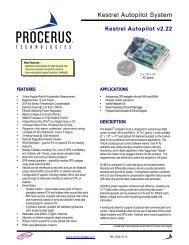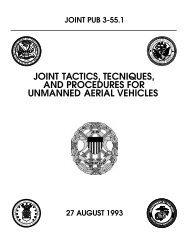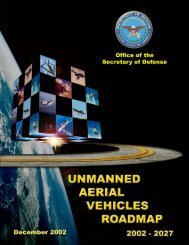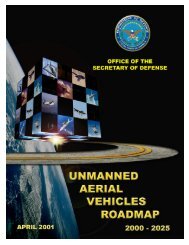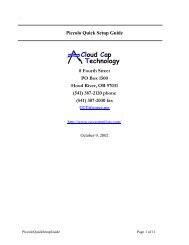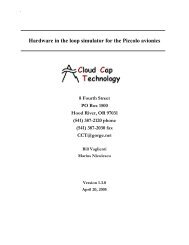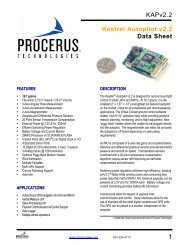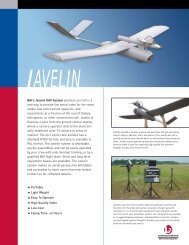Download - Unmanned Aircraft & Drones
Download - Unmanned Aircraft & Drones
Download - Unmanned Aircraft & Drones
Create successful ePaper yourself
Turn your PDF publications into a flip-book with our unique Google optimized e-Paper software.
Ground Control and SimulationVIRTUAL COCKPIT v2.0UAVModesAgent ListHeads UpDisplay(HUD)GeoreferencedMapsMessageWindowFlight PlanWaypointsPre-FlightTools andTimersTakeoff &LandingSettingsEASE OF USEThe Virtual Cockpit provides an easy-to-use interface to the Kestrel Autopilot System. Our focus has been to provide aclean, uncluttered main screen that provides easy access to all the flight and navigation capabilities of the autopilot. TheVirtual Cockpit has been enhanced to make normal flight operation easier and more intuitive while providing different levelsof autonomy. This includes the capability to place the autopilot into a number of pre-configured modes, for example: Gohome, Loiter at current location, Take off, and Land. With just a click of the button the autopilot executes the desiredaction, leaving the ground operator to be able to observe other important tasks such as video monitoring.ROBUST FEATURE SETThe capability to harness the power of the autopilot through the Virtual Cockpit becomes evident when users are able toquickly re-task and reconfigure the autopilot while it’s flying safely. A unique ability in the Kestrel Autopilot system is theonboard precision data logger. This feature allows the ground operate to data log variables and information directlyonboard the autopilot at a high rate (up to 100 Hz). Using the simple interface of the Virtual Cockpit, operators can selectfrom a large list the values that are required to be store, the recording rate, and the recording time. When the autopilot hasfinished data logging, the Virtual Cockpit downloads the information and saves to either Microsoft Excel file format orMathworks Matlab format.2
Ground Control and SimulationMultiple UAVs Even Easier NowMonitoring multiple UAVs can be a daunting task. There are many status values to continuously monitor, from autopilotbattery voltage to loss of Comm and GPS lock failure. The Virtual Cockpit has minimized this effort by adding text andaudible warning sounds that are user configurable. To add to this simplification a message window has been added to theVirtual Cockpit that prioritizes warning messages and tasks in order of priority as they need to be addressed.Features:Mode Support - single click autopilot configurations• Rate mode - rates only, activated by switch on RC transmitter• Speed mode - aircraft holds airspeed using pitch, (roll, airspeed, and throttle commands on ground station)• Altitude mode - aircraft holds altitude (roll, airspeed, and altitude commands from on ground station• Nav mode - aircraft navigates to standard and loiter waypoints• Home mode - aircraft flies home and loiters• Take off mode - aircraft uses preset commands – automatically transitions to Nav mode at pre-set altitude• Loiter now mode - aircraft loiters at current position• Land mode - aircraft flies to landing point on map and lands• Rally mode - aircraft flies to Rally point (landing Approach point)Gimbal Camera and Game Pad Controller support• 2 axis stabilized gimbal support with manual control through joy stick.• Ability to manipulate UAV in a natural way without RC experience or RC controller.Convoy Following Support• Now with GPS on the Commbox ground station, users can manage multiple UAVs in convoy following applications.Precision Data Logger and Telemetry Support• Fully configurable including: 1) Sample rate (up to 100 Hz) 2) Log duration 3) Sample count• Choose sensors and variables to log:o All sensors, control inputs, control outputs - PID data for gain tuning and analysis - Internal system variables• When logging is complete, Virtual Cockpit downloads and saves to Microsoft Excel or Mathworks Matlab file format• Telemetry Replay Window for replaying and analyzing flightIntegrated Video Support• Play live video from airplane using a PCMCIA real time capture card• Overlay state information as text onto video• Snap single images from video with and without text overlay and save as a windows bitmap• Record compressed video• Select video size from 320x240 to 640x480Integration and Configuration Screens• PID Tuning screen for in-flight gain tuning along with real-time performance graph.• Autopilot sensors screen for monitoring and calibrating autopilot sensors• Servo adjustment screen for integrating control servos and payload servos• General autopilot configuration for easy adjustments for different airplane setupsHardware-in-the-Loop Simulation Environment – 6 DOF simulator for development purposes and gain tuning• Simulation environment can be customized: Wind, Sensor and Actuator dynamics, Stability Derivatives.• Video can be exported for target tracking or computer vision algorithm development3
Ground Control and SimulationData Log WindowA feature that is unique to the Virtual Cockpit is the in-flight gain tuning with real-time performance graph. By using thissystem, operators can tune the Kestrel to best suit their airframe design.4PID Tuning Window
Ground Control and SimulationThe Virtual Cockpit automatically data logs the standard telemetry received from the airplane. This information can be vitalfor solving problems or for post-processing a past flight. The Virtual Cockpit makes replaying previous flight data easy withits built-in replay capability.Telemetry Replay WindowThrough the replay window, users can pause, rewind, and fast forward a past telemetry file while the Virtual Cockpitbelieves that it is actually receiving standard telemetry from an airplane. Replaying the telemetry file displays all of theflight’s properties including warnings and messages that may have occurred during the flight.In addition to these features, the Virtual Cockpit is capable of saving the work that goes into configuring and airplane alongwith flight plans and save this information to individual files. The files can then be loaded and copied into a differentairplane, thus minimizing the time to setup multiple airplanes.3. INTEGRATION AND CONFIGURATIONThe Procerus "Time to Flight" Initiative reduces the complexities of integration and configuration through easy to use tools.What matters: 1) Robust Guidance & Control. 2) Easy and Successful Integration. 3) Repeatability.In addition to important new features, greater sophistication, and ease of use, a major focus with the release of the newVirtual Cockpit 2.0, the Kestrel Autopilot 2.2, and autopilot firmware MA5 level code was to directly address the challenge ofintegration. We've focused on the steps and activities related to successful and "repeatable" UAV operation by making iteasier to tune the autopilot to a particular airframe in less time. This means getting in the air quicker with a more reliable,robust, and consistently reproducible solution.Autopilot ConfigurationNot only is the Kestrel 2.2 thesmallest and lightest fullfeaturedautopilot on themarket, but the completesystem sets a standard forease of integration andconfiguration.By grouping related variableand tuning parameters intoeasy-to-use screens that aremore intuitive, easier tounderstand and use,integrators can now morequickly tune the Kestrelautopilot for their particularairframe(s), thereby speedingsuccessful "time to flight".5
Ground Control and SimulationServo Trims / TravelWith the new integrator’sconfiguration screens, theVirtual Cockpit makes the taskof adapting the KestrelAutopilot to a new airframeeasy. Each new configurationscreen focuses on a keyintegration aspect, forexample, a servo setupwindow has been added thatallows integrators to configureservo trims along with servotravel. This includes the abilityto command the autopilot tocontrol the servo deflectionand then allows the integratorto measure on the actualairframe the deflection of thecontrol surface and makeadjustments as needed. The user can turn on auto-trim thus telling the autopilot to automatically trim the aircraft while in theair. The values are then stored on the autopilot.Sensor ConfigurationIn addition to the variableand servo configurationscreens, users can verifysensor outputs arefunctioning properly on theAutopilot Sensors window.Reconfiguration of themagnetometer andtemperature compensationpoints can be accessedthrough the Virtual Cockpitwith a click of a few buttons..6
Ground Control and SimulationWarning ConfigurationSituational awareness is atop priority of the VirtualCockpit. Integrators canreconfigure the warningsystem that is used in theVirtual Cockpit, allowing foraudible warning sounds andalerts in the messagingwindow. Sound files can becreated to suit user interestand requirements.TCPIP Development InterfaceThe latest version of the Virtual Cockpit,along with the Developers Kit, includes aTCP/IP server for remote applications toconnect directly to the Kestrel Autopilot andaccess many of the advanced features ofthe autopilot. This dramatically cuts downon the time to add new abilities to theground station while reducing developmenttime.Developers can now send pass-throughpackets through the VC to the Kestrelautopilot without needing to understand thefull Communications Protocol Specification.The packets are sent to the VC through aTCPIP socket connection. An Open Sourceexample application is provided to speeddevelopment. Developers can utilize thebase functionality of the Virtual Cockpitwhile creating plug-in apps with theextended functionality needed fordevelopmentOpen Source Application provided with Developers Kit7
Ground Control and SimulationOPEN SOURCE SIMULATIONENVIRONMENTAviones Flight SimulatorThe Kestrel Autopilot and the Virtual Cockpithave a built-in ability to simulate a 6 degree offreedom UAV through the use of a 3rd party,open source simulator called Aviones. Avionesuses user-defined stability derivatives toaccurately simulate the aircraft flightcharacteristics. This is useful for tuning gains,developing new navigation and controlalgorithms, or gaining familiarity with the systembefore flying. This approach can significantlyreduce the risk of the first flight in a new airframeor testing new code on the autopilot or groundstation. Developed by Brigham YoungUniversity, Aviones (subject to GNU PublicLicense) provides a robust test and simulation environment.Aviones is a hardware-in-the-Loop (HIL) simulator that operates with the Kestrel Autopilot. You can also simulate multiple UAVs inflight (requires multiple Kestrel autopilots).Aviones uses loadable code libraries for simulation; physics and autopilot libraries. The physics library computes how the airplaneresponds in its natural environment using user-definable airplane coefficients, wind, and 6 degree of freedom models. The otherlibrary describes the autopilot and how it will respond to its orientation and position in the simulated world. By using Procerus’proprietary autopilot DLL, Aviones can communicate with the Kestrel Autopilot and replace the autopilot’s sensor information withthat generated by the physics library. After the Kestrel receives the sensor information it can compute a controller output which is fedback into the physics library. All throughout the process, the Virtual Cockpit can communicate to the autopilot through a TCP/IPsocket connection to Aviones. The figure below shows the relationship between the various sub-systems.VirtualCockpitTCP/IPAvionesPhysics.dllProcerus Modifications:Procerus has modified the open source Aviones Simulator so that itcontains a Hardware in the Loop simulation control window. Using thiswindow a user can specify the UAV’s starting Latitude, Longitude, andAltitude. The user can also change the serial communications portallowing for multiple hardware in the loop simulator agents.Autopilot.dllSerialKestrelWe’ve also added the ability to issue commands to the HIL simulation.These commands include: Loss of GPS, Loss of Communications, andEngine Failure. Issuing these commands allows the developer to testfailsafe conditions with their modified algorithms.System communication configuration8



